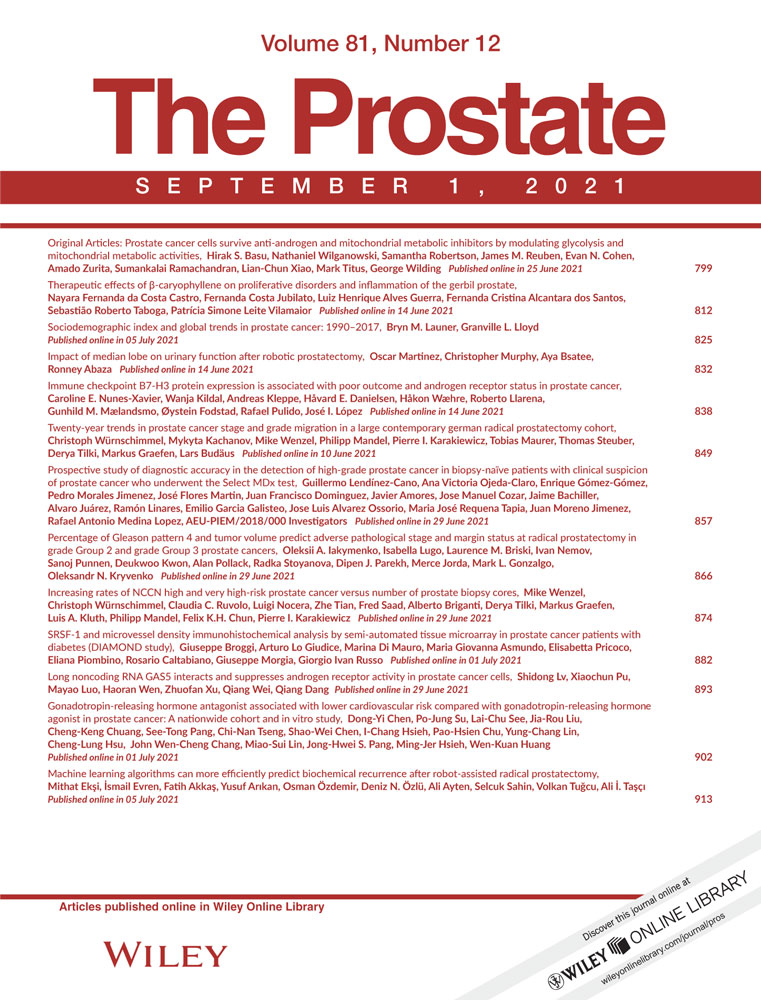Percentage of Gleason pattern 4 and tumor volume predict adverse pathological stage and margin status at radical prostatectomy in grade Group 2 and grade Group 3 prostate cancers
The data were presented in part at the 108th Annual Meeting of the United States and Canadian Academy of Pathology (USCAP), March 16–21, 2019, National Harbor, Maryland, USA.
Abstract
Background
Increasing percentages of Gleason pattern 4 (GP4%) in radical prostatectomy (RP) correlate with an increased likelihood of nonorgan-confined disease and earlier biochemical recurrence (BCR). However, there are no detailed RP studies assessing the impact of GP4% and corresponding tumor volume (TV) on extraprostatic extension (EPE), seminal vesicle (SV) invasion (SV+), and positive surgical margin (SM) status (SM+).
Methods
In 1301 consecutive RPs, we analyzed each tumor nodule (TN) for TV, Grade Group (GG), presence of focal versus nonfocal EPE, SV+ , and SM+. Using GG1 (GP4% = 0) TNs as a reference, we recorded GP4% for all GG2 or GG3 TNs. We performed a multivariable analysis (MVA) using a mixed effects logistic regression that tested significant variables for risk of EPE, SV+, and SM+, as well as a multinomial logistic regression model that tested significant variables for risks of nonorgan-confined disease (pT2+, pT3a, and pT3b) versus organ-confined disease (pT2).
Results
We identified 3231 discrete TNs ranging from 1 to 7 (median: 2.5) per RP. These included GG1 (n = 2115), GG2 (n = 818), GG3 (n = 274), and GG4 (n = 24) TNs. Increasing GP4% weakly paralleled increasing TV (tau = 0.07, p < .001). In MVA, increasing GP4% and TV predicted a greater likelihood of EPE (odds ratio [OR]: 1.03 and 4.41), SV+ (OR: 1.03 and 3.83), and SM+ (1.01, p = .01 and 2.83), all p < .001. Our multinomial logistic regression model demonstrated an association between GP4% and the risk of EPE (i.e., pT3a and pT3b disease), as well as an association between TV and risk of upstaging (all p < .001).
Conclusions
Both GP4% and TV are independent predictors of adverse pathological stage and margin status at RP. However, the risks for adverse outcomes associated with GP4% are marginal, while those for TV are strong. The prognostic significance of GP4% on BCR-free survival has not been studied controlling for TV and other adverse RP findings. Whether adverse pathological stage and margin status associated with larger TV could decrease BCR-free survival to a greater extent than increasing RP GP4% remains to be studied.
CONFLICT OF INTERESTS
The authors declare that there are no conflict of interests.
Open Research
DATA AVAILABILITY STATEMENT
The data that support the findings of this study are available from the corresponding author upon reasonable request.




